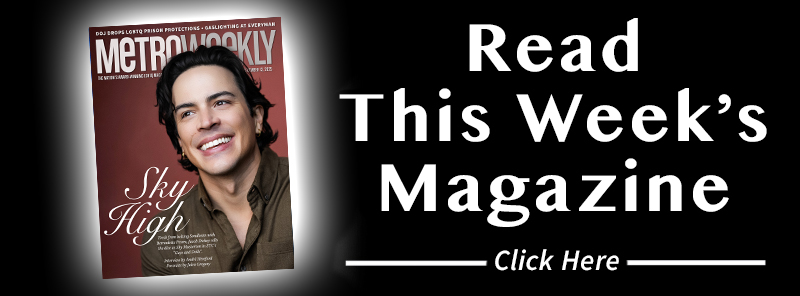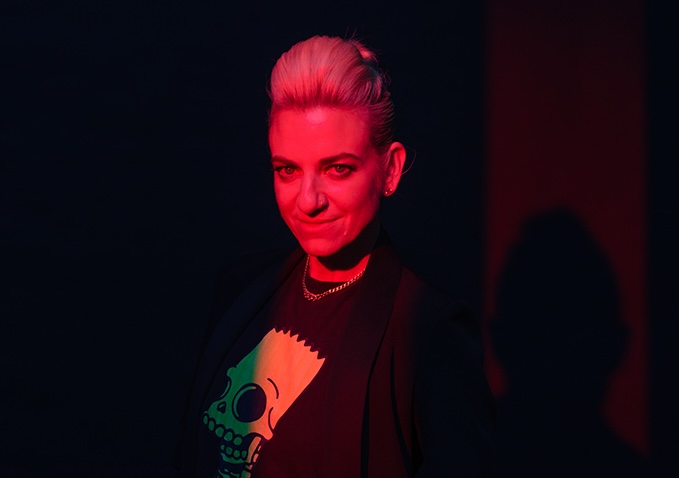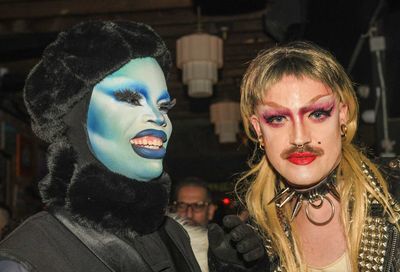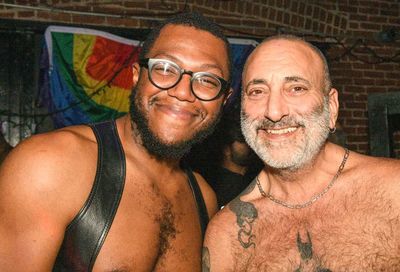Scary Movies
According to Andy Scahill, gays have a special dark place in the horror canon
SCAHILL: Yeah, absolutely. There’s this mounting danger of sex in any horror. I agree with that in part — especially in slasher film where, if you have sex, you die. But I think, if you think about when we’re most vulnerable, it’s when we’re naked. It’s when we’re in the shower. I think you can read it as puritanical, but I think it’s also just about our anxieties about vulnerable states. Sex makes us vulnerable. Being naked makes us vulnerable, and those are the frightening things. Being asleep makes us vulnerable. And often characters are attacked while they’re sleeping, or even in dreams. There’s nothing puritanical about that. I think it’s overall anxiety about those moments in which we haven’t armored ourselves in every way.
MW: So even if we become a really sex-positive society, sex is still going to be at the crux of a lot of horror?
SCAHILL: Absolutely. The subconscious is this vulnerable state, and I think a lot of times in the greater straight culture, there’s anxiety about, if I probe my subconscious, what am I going to find there? Am I going to find this hidden queer monster that I have to repress again? The horror film is also in a way about how repression fails over and over again. And that stuff that we repress, be it our own desires or be it other races, or women, that comes back for revenge in the horror film.
A little bit of repression is good for society — if we repress our desire to injure other people, or what-have-you. But we have lots of things that we repress in society that we don’t need to — women, other cultures, children, the poor. And often in the horror film, this is what comes to the surface, and comes back for revenge.
MW: One of the terms you reference in the book that really stood out for me, in context of The Exorcist in particular, was about “baby bitches from hell.”
SCAHILL: Yeah, that’s a great one! That’s Barbara Creed. I think that’s a really good example of not only repressing children, but we’re repressing women. And repressing our own sexuality. Part of the horror of The Exorcist is that she’s on the cusp of womanhood, and all of this is coming to the surface. The anxiety about menstruation. Carrie also deals with this.
MW: I imagine The Exorcist has a special meaning to you, as it does to many Washingtonians or those associated with Georgetown. I know you’re going to be at the official dedication of the Exorcist Steps this Friday, Oct. 30.
SCAHILL: I’m excited for the event. It’s interesting, when I was at Georgetown, the window out of my office looked out over the church, which starts the film. So I had that steeple in my window every time I was in Georgetown.
I can’t think of too many horror films in which the location becomes a mecca. But it is here. What would otherwise be, in any other movie, a nondescript staircase, takes on an aura in The Exorcist. I can’t think of too many examples where people make a mecca to something so banal as an entrance to a house.
MW: Did director William Friedkin set a new bar for horror films with The Exorcist?
SCAHILL: Yes, for a couple of reasons. William Friedkin has this interest in art cinema. We see this art cinema aesthetic at times in dream sequences. Along with Rosemary’s Baby and The Shining, those three films I think really took horror up as a genre, to where you could have an artistic, existential even, horror film. One made for the mass market, but still allowing you to do these sort of artistic flourishes. And I think that was a rarity in horror cinema, or genre cinema up until that point. To have this mixture of art and horror, a pulpy genre.
MW: Another notable thing about The Exorcist was how scary the medical tests were and how it preyed on people’s fears or misunderstandings about medical science and the powers of medicine.
SCAHILL: Yeah, something like that hadn’t really been seen before. We might call that kind of medical horror.
In the film, they even align the medical community as this sort of priest exorcism — and putting really violent acts upon the girl’s body. The mother, when talking about the exorcist, she calls him the witch doctor, which is interesting given that we have this invasive medical procedure as well. I look at that scene specifically when I do a queer reading of the film.
MW: Are you saying there’s a gay angle to it?
SCAHILL: If you’re just watching it as author William Peter Blatty intended, you think of the movie as a story of rescuing a girl from possession. Another way to read it though is as a story of revenge — against the state, against the medical community. That the possession allows her body to revolt against these medical/religious invasions of her body. And I find it very pleasurable to watch her body revolt. I don’t think I’m supposed to. I don’t think the movie is necessarily made for that type of pleasure. And yet, I think a lot of people find it really pleasurable to watch her vomit on a priest. When I screen that film with my students, the students laugh at that scene. What does that say about their spectatorship?
MW: That they’re lapsed Catholics?
SCAHILL: Right. I mean, that’s me for sure. And I think, for an institution that’s been so antagonistic towards my body and my desire, it’s really pleasurable to watch a body on screen be antagonistic towards that, that institution. And when I look at how people have taken up the image of Regan MacNeil, in parody or in public discourse, or even jokes, there is something pleasurable in the way that her image has circulated.
MW: Is The Exorcist your favorite horror film?
SCAHILL: I’m a classic guy. I love the classic haunted house tale — so The Haunting is probably my favorite. Robert Wise’s 1963 original. And it became the template for every horror film after it, from The Shining to The Babadook — they’re all circling back to it. And I think what’s brilliant about it, is that it plays on that boundary between, is it supernatural or is it psychological? And I always like that kind of tension.
MW: What would be your least favorite horror film?
SCAHILL: It would probably be — I haven’t seen it — but Saw, what people call torture porn. Because what I like is the thoughtfulness and the ability to suggest without showing. I feel like these films are just splattered bukkake, really. I just find that they show too much and tell too little.
MW: Is the psychological aspect why horror is more fascinating to gay people in general, because coming out and accepting your identity is an inherently psychological act?
SCAHILL: Yeah, absolutely. You know, I’m a Hitchcock guy. I love Psycho. I love The Birds. He once said, you can give your audience a 10-second shock, and they’re shocked for 10 seconds. Or, you can tell them something is coming, and you can let the scene play out for 10 minutes, and you get that 10 minutes of anxiety and anticipation and dread. And that’s really the crux of it.
He was also really interested in perverse sexualities. So there are many characters that could quite easily be read as gay — Bruno in Stranger On a Train, often Anthony Perkins in Psycho is read as a latent homosexual. Hitchcock was really interested in the failure of repression, too. And also his queer characters — especially Bruno in Strangers On a Train — they had a lot more mobility, because they knew how to perform. They could put on the mask when they needed to, and take it off when they had to, or wanted to. And that’s one of the things I got really interested in with these horror films about children. Because so much of it is about performing the expectations of a good child. I think that’s something that resonates with us a lot, those of us who grew up gay and knowing that something was different about us. Having to understand what the expectations are and to try to perform them.
MW: Do you remember the first horror film that you ever saw?
SCAHILL: You know, a lot of people talk about The Wizard of Oz as their first horror film. Which I think is kind of funny, how many young people get traumatized by that film.
MW: I guess I’ve always thought of that film as a kind of gay kid’s fantasy — and not simply because Judy Garland is the star. It’s the opposite of a horror film to me.

SCAHILL: Well the witch and the flying monkeys — and all the darkness, twisted-ness of that arena. It’s interesting, the production of the film, they actually dialed back a lot of Margaret Hamilton’s scenes because they tested so poorly with children. So they refused a lot of her more aggressive scenes to make it more child-friendly.
My parents wouldn’t have let me see a horror movie early on, so it was probably one of the slashers. I want to say Nightmare on Elm Street just because I feel like it has such a permanent place in my mind. But I don’t remember being traumatized by it. If anything I probably found it wildly entertaining.
MW: Are you watching American Horror Story? What do you think of it?
SCAHILL: I was a fan of the first season. I haven’t watched this season yet. I think of American Horror Story as a kind of pastiche or jukebox of horror film references. And there are different levels of pleasure. I think it works on its own, if you’re just enjoying the pulpiness of it, and the taboo-breaking of it — which I think is a big part of American Horror Story, in that it really tries to obliterate taboos. It’s fascinating that this has become so successful with an American audience. But I also think it works on that level of saying, oh, okay, I know that reference from Freaks or from Halloween or from Sleepaway Camp. So it works on that level.
For me, it becomes more of a program with too large of a cast, telling too many stories. And it becomes unable to tell a single story. That’s the problem with a lot of ensemble shows. So for me, I would just wish it would focus in on one or two stories.
MW: What would you say is the future for gays in horror films?
SCAHILL: I think we’ll start to have more gay voices in production. We’ve been questioning the easy answers that horror used to give us, about who was good and who was the monster. And I think more and more we get into the horror of normativity, and the horror of losing identity within the horde. I think the rise of the zombie movie kind of speaks to this. Because what is the zombie movie except the loss of individuality, and the loss of self amidst the horde?
Zombie movies have been interpreted hundreds and hundreds of ways. They’re so semiotically empty that they can be a critique of consumerism, they can be a race critique, they can be about our reactions to global crises. But at their heart I think they are about the loss of self.
MW: And vampires are another perennial category in which gays sometimes play a part.
SCAHILL: Yeah, vampires have undergone a real renaissance. We poo-poo Twilight a lot, but I call it the domestication of the vampire. I miss the old vampires. I like when they represented pure polymorphous perversity, pure libido, and they were dangerous and erotic. Instead, they’ve become really synonymous with almost creating families of their own. And True Blood takes part in this as well — it’s really domesticating this anarchic figure. They used to be pure sexual anarchy, but now they just want a family. They want to settle down.
MW: And what could be more horrific than that?
SCAHILL: Right? If you look at Twilight, it’s obviously the good, white, hetero-normative vampires that play baseball and eat apple pie against the nomadic, often nonwhite tribes of vampires — they’re the bastards. They’re the ones that can’t settle down and form families and really inculcate to this American way of life.
The Revolting Child in Horror Film: Youth Rebellion and Queer Spectatorship ($95) is published by Palgrave Macmillan (October 2015). It is available on Amazon.com.
The Exorcist Steps, 3607 M St. NW, will be dedicated in a ceremony featuring the film’s director William Friedkin and writer William Peter Blatty this Friday, Oct. 30, at 4 p.m. Visit film.dc.gov.
Support Metro Weekly’s Journalism
These are challenging times for news organizations. And yet it’s crucial we stay active and provide vital resources and information to both our local readers and the world. So won’t you please take a moment and consider supporting Metro Weekly with a membership? For as little as $5 a month, you can help ensure Metro Weekly magazine and MetroWeekly.com remain free, viable resources as we provide the best, most diverse, culturally-resonant LGBTQ coverage in both the D.C. region and around the world. Memberships come with exclusive perks and discounts, your own personal digital delivery of each week’s magazine (and an archive), access to our Member's Lounge when it launches this fall, and exclusive members-only items like Metro Weekly Membership Mugs and Tote Bags! Check out all our membership levels here and please join us today!




























You must be logged in to post a comment.